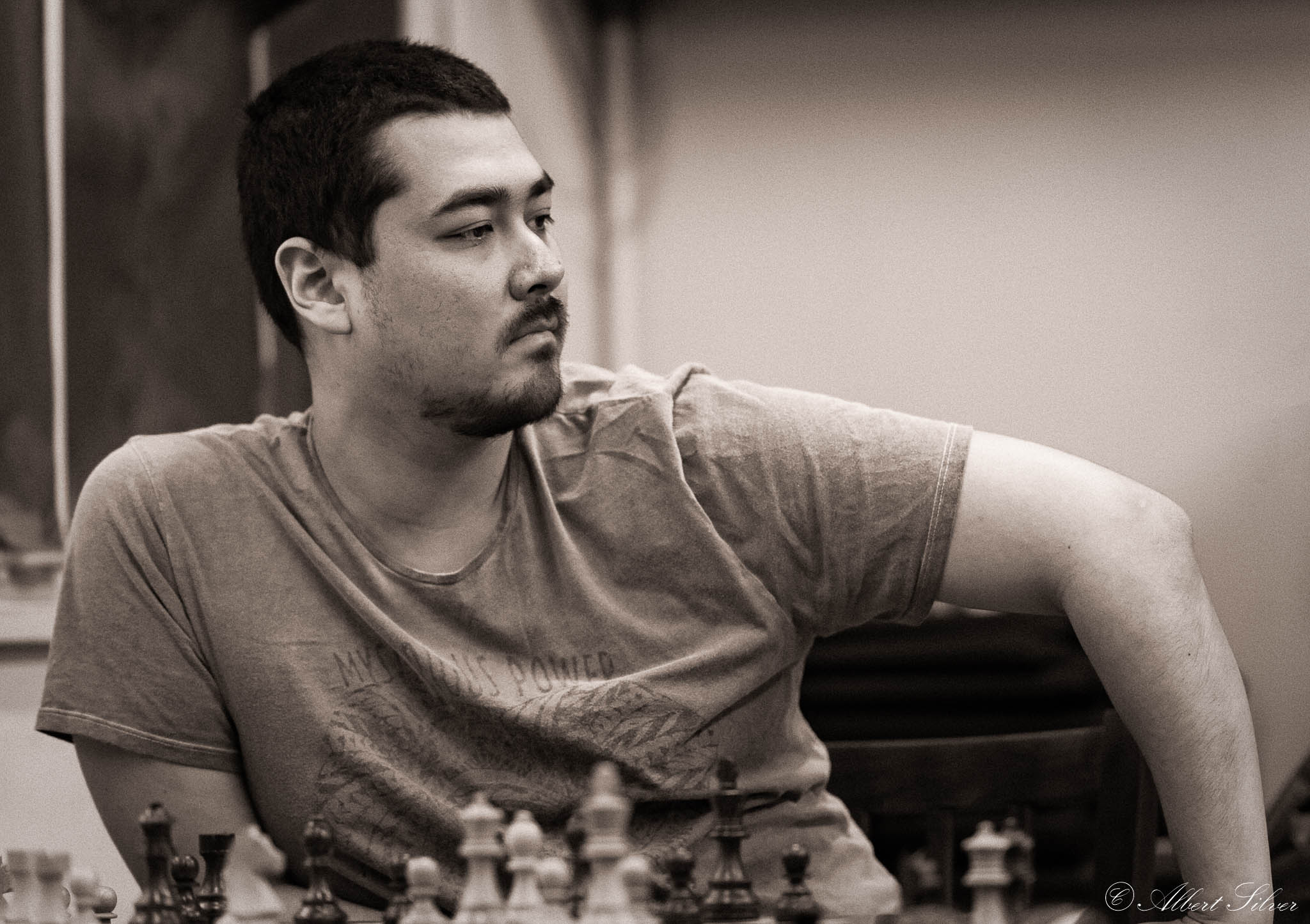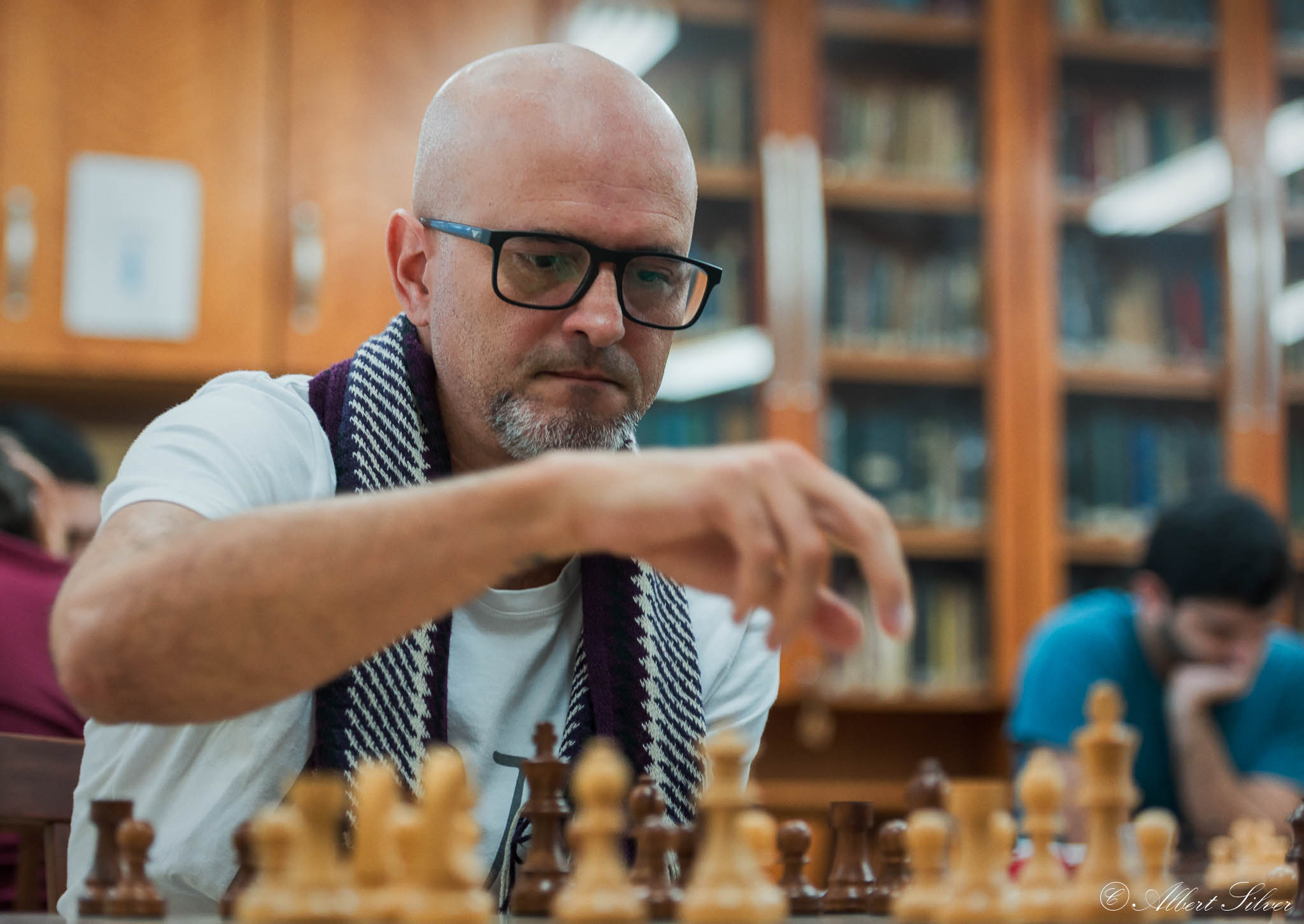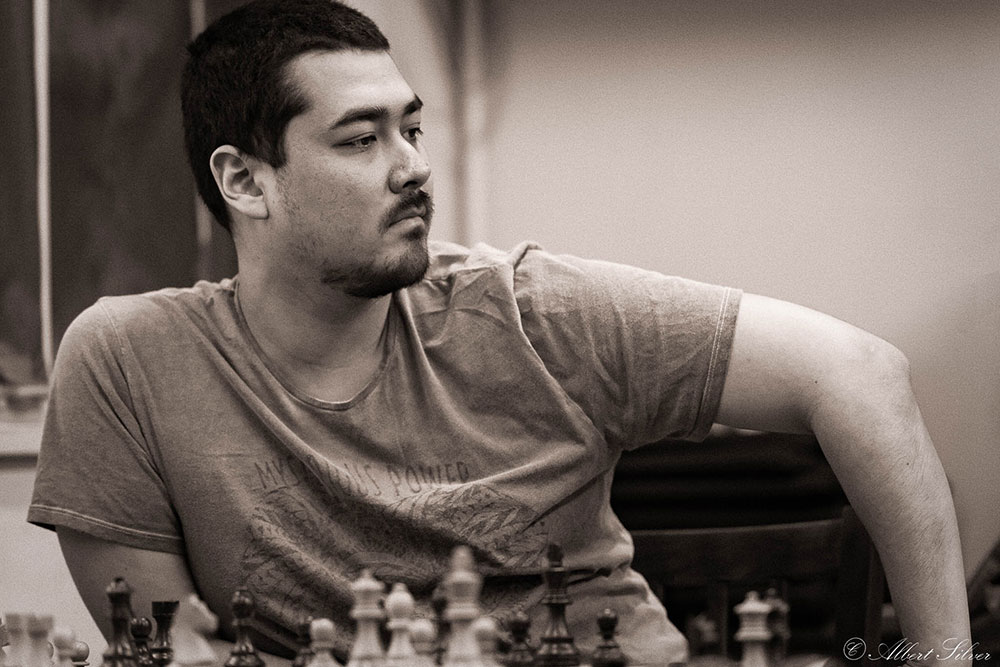Photos by Albert Silver
It was the third straight year the Brazilian Championship was held in Rio de Janeiro, Brazil, and this time it was also organized precisely during the Carnaval. Last year the president of the Brazilian Federation, GM Darcy Lima, had said he planned to organize this year as a series of matches much like the World Cup, and the defunct Knockout World Championship, with more players participating, more prize money, and more excitement for fans following it.
Although it brought in no fewer than five grandmasters, the star of the event no matter the result was without question GM Henrique Mecking. This was his fourth participation overall, his first two taking place in 1965 and 1967, both of which he won at ages 13 and 15 respectively, and then in 2011, when he came in third. In Brazil, and even South America in general, just the name will ensure a draw even though he is past his prime and no longer the walking tour-de-force he once was.

Henrique Mecking is always a draw in a tournament in Brazil
To understand the eternal fascination he causes, it goes beyond just being the greatest South American player ever. Obviously he was a prodigy of incredible talent, who came from a country with none of the deep chess culture nations in East Europe had such as the Soviet Union, or even the United States. Not only did he overcome this lack of access to training and literature that would normally hamstring any lesser player, but also played in extremely few tournaments. In spite of these handicaps, he rose to world no.11 in 1974 at age 22, and remained in the top ten players until 1979, peaking at world no.3 behind Korchnoi and Karpov. He won two Interzonals, and made it to the quarter finals of the Candidates matches twice. In 1979 however, he was diagnosed with myasthenia gravis and told he had weeks to live. He dropped out of chess altogether and did not play during the 80s, missing out on what would have most likely been his golden years.
What brought him back to the championship? As Darcy Lima explained, the minute it was decided that the format would be a series of small matches, Mecking came to mind as he had already commented on his interest in matchplay.
Completing the lineup of grandmasters were Alexandr Fier, Krikor Mekhitarian, defending champion Everaldo Matsuura, and Luis Paulo Supi, as well as a number of international masters and FIDE masters.

Alexandr Fier was the second seed
The first round saw no real surprises as far as those who advanced to the next round were, though a rather notable issue was with Mecking himself as he drew his much weaker opponent in the classical games, before dispatching him in the rapid tiebreaks.
In the second round, now down to eight players, the favorites still passed through cleanly with 2-0 scores with the exception of Mecking once more. Mequinho (pronounced meh-keen-yo), as he is called in Brazil, faced IM Christian Toth, and though he was once more the outright favorite on papers, had even needed to save a lost endgame in game one.

IM Christian Toth had a moral victory as he drew both his standard games against GM Mecking
Game two was less dramatic over the board, but the danger of another draw was clearly rattling him, he complained about his opponent’s behavior at the board, claiming he was ‘doing gymnastics’ at the board. While Toth does stretch discretely in his chair more often than most, as a result of his years of studying yoga in India (really), calling it gymnastics was a gross exaggeration.

'Gymnastics'
Toth’s grimace of frustration was visible from across the room as the arbiter calmed Mequinho down. They drew game two and it was in the rapid tiebreaks that once more Mecking showed his true strength.

FM Armen Proudian
His lack of form was finally punished as he met GM Krikor Mekhitarian in the semifinals and lost, while Alexandr Fier beat Luis Paulo Supi. Supi is a player on the rise, and is only waiting for the next congress to receive his title. In the past two years the 21-year old player has gained over 100 Elo, going from good IM rated 2449 to 2553 this year and all the GM norms he needs. Nevertheless, he faced the no less strong, and more experienced GM Alexandr Fier (pronounced ‘fear’), and after drawing their first game, lost the second.

Though officially an IM until his GM title is confirmed at the next FIDE congress, Luis Paulo Supi was the third seed with 2553 FIDE
This meant a final showdown between Mekhitarian and Fier over four possible games for the title. The timing of the tournament and final collided with Carnaval, and took a toll on live spectators.

Fans enjoyed coming to the venue all the same to follow the games. FM Hilton Rios was there every day.
While Carnaval is celebrated in many places around the world with parties, parades and more, in Brazil it is an official holiday, and as such, businesses close, schools are off, and the country does go quite nuts as they carouse. That said, this is where the internet becomes the great savior of chess, since, as the Federation pointed out, the number of visitors of the official Facebook page and the live games on a variety of servers, including Playchess, made it clear that although there might not be long lines to enter the fine venue in the Novotel downtown, interest was very high.

The start of game three and last game of the 84th Brazilian Championship between GM Krikor Mekhitarian and GM Alexandr Fier
Alexandr Fier had a dream start, winning his first two games, meaning only a draw in the next two games was needed to crown. Game three was by far the most fascinating of the match, as Krikor Mekhitarian fought tooth and nail to win it and stage a memorable comeback, and he so nearly did. As he later explained, it was a strange thing, since when Fier arrived in Brazil, they had gotten together to train for tha myriad events they would be playing in. Fier’s presence in Brazil was the product of a three-way collaboration between organizers and the federation, which was how he came to play in the Floripa Open, and now in the Brazilian Championship. Now the training partners and friends found themselves seated at opposite sides of the board for the coveted Brazilian title. For Fier it would be his second title, while Krikor was hoping for a third.

Krikor Mekhitarian put in all his energy to try to win game three, and his efforts were noticeable on the board and in his demeanour

Ultimately, it was Alexandr Fier who came out on top and this won his second title after a 13-year hiatus

[Event "84th BRA-ch 2017"] [Site "Rio de Janeiro"] [Date "2018.02.14"] [Round "4.3"] [White "Mekhitarian, Krikor Sevag"] [Black "Fier, Alexandr"] [Result "1/2-1/2"] [ECO "A30"] [WhiteElo "2529"] [BlackElo "2557"] [Annotator "Albert Silver"] [PlyCount "211"] [EventDate "2018.??.??"] [EventType "k.o."] [EventCountry "BRA"] [SourceTitle "playchess.com"] [Source "ChessBase"] [SourceQuality "1"] 1. Nf3 Nf6 2. c4 c5 3. Nc3 e6 4. g3 b6 5. Bg2 Bb7 6. O-O Be7 7. Re1 d6 8. e4 a6 9. d4 cxd4 10. Nxd4 Qc7 11. Be3 Nbd7 12. Rc1 Ne5 {Play has resulted in a classic hedgehog.} (12... Rc8 13. f4 Qb8 14. g4 h5 15. g5 Ng4 16. g6 Rxc4 17. gxf7+ Kxf7 18. Bf1 Nxe3 19. Rxe3 Rxd4 20. Qxd4 b5 21. Rg3 Bf6 22. e5 Bd8 23. Ne4 Bb6 {0-1 (23) Ding,L (2774)-Carlsen, M (2837) Saint Louis 2017}) 13. Bf4 $146 ({Naiditsch once played the hyper-aggressive} 13. Nd5 exd5 14. cxd5 Qd7 15. Nf5 O-O 16. f4 Ng6 17. h4 Nxd5 18. Bd4 Nf6 19. h5 Rfe8 20. hxg6 hxg6 21. Nxe7+ Rxe7 22. Bxf6 gxf6 {1/2-1/2 (53) Naiditsch,A (2700)-Meier,G (2644) Dortmund 2012}) 13... Ng6 14. Bd2 Ne5 {White is slightly better.} 15. Bf1 Rc8 16. b3 O-O 17. h3 Qb8 18. Qe2 Rfe8 19. Bg2 Ned7 20. g4 g6 21. Bh6 e5 22. Nc2 Bf8 23. Bd2 Nc5 24. Qf3 Nfd7 25. Nd5 Ne6 26. Be3 Bg7 27. Qd1 b5 28. cxb5 axb5 29. Bf1 Ndc5 30. f3 {While nothing is decided, the imbalanced position is exactly what White wants in order to be able to leave the chair with a full point on the board.} (30. Bxc5 {keeps more tension.} Rxc5 31. b4 Rxc2 32. Rxc2 Nd4 33. Rc3) 30... Bxd5 31. Qxd5 Nd4 $1 {Krikor's fans watching with the help of an engine probably had minor heart attacks here. Not only is this move very strong, but Black might even have taken the advantage.} 32. Nxd4 exd4 33. Bxd4 Bxd4+ 34. Qxd4 Ne6 $2 {Missing his chance!} ({Black missed a prime chance to really hit back with} 34... d5 $5 {not only would it attack White's stronghold in the center, but it threatens alll manner of nastiness with Qg3+. In fact White would lose a rook by taking d5 here with} 35. exd5 Qg3+ 36. Bg2 Rxe1+) 35. Qf2 Nf4 36. Red1 g5 37. Qd4 Ne6 38. Qe3 Nf4 39. Kh1 Rxc1 40. Rxc1 d5 41. Qc5 $36 {White smells blood} Qe5 42. exd5 $1 Ne2 {[#]} 43. d6 $1 {This nice little tactic will yield a strong endgame for White.} Nxc1 44. d7 ({And not} 44. Qxc1 Rd8 $17) 44... Qxc5 45. dxe8=Q+ Kg7 46. Qxb5 Qe3 {Avoiding the exchange of queens while keeping an eye on the g5 pawn and the knight on c1.} 47. Qd5 {[#]} Nxa2 48. Bc4 Qf4 49. Qe4 Qf6 50. Kg2 h6 51. Qf5 ({Better is} 51. f4 $16 {with a significant edge for White.}) 51... Qxf5 $14 52. gxf5 {White has finally gotten his exchanges.} Kf6 53. Kg3 Kxf5 54. Bxf7 Nb4 55. Bg8 Kg6 56. Bc4 Kf5 57. Bb5 Nd5 58. Bc6 Nb4 59. Be4+ Ke5 60. Kg4 Kf6 61. Kh5 Kg7 62. h4 Kf6 63. Kg4 Na6 64. Bd3 Nb4 65. Be4 Na6 $1 66. f4 gxf4 $2 (66... gxh4 $16 { is a better defense.} 67. Bb1 (67. Kxh4 Nc5 $16) 67... Nc7) 67. Kxf4 {As promising as it might seem, this endgame is a tablebase draw. One of the key aspects is the matter of the bishop and h-pawn. If the b-pawn is removed, White cannot win even if black lost all his material since the bishop is the wrong color and does not control the h8-square.} Nb4 68. Bf3 Nc2 $2 {This is a tremendous blunder that gives White a winning position.} 69. Bd1 Nb4 70. Ke4 Na6 71. Kd5 Nb4+ 72. Kc4 Nc6 73. Kc5 Ne5 74. Bc2 Nf3 75. h5 Ke5 76. b4 Nd4 77. Bg6 $2 {This is the blunder that now allows Black to save the game.} ({The only move that still won for White is} 77. Bd3 {which wins still according to 7-piece tablebases. However, as to explaining it over other moves, that would take considerable analysis.}) 77... Ne6+ 78. Kc4 Kd6 79. Bf7 Nf4 80. b5 Ne2 81. Bd5 Nf4 82. Bf3 Kc7 83. Kc5 Ne6+ 84. Kd5 Ng7 {White was still in shock as it dawned on him the win had slipped away, and the next 20 odd moves were a reflection of this rather than renewed attempts at a swindle. Mekhitarian was clearly upset at the board, and playing more to calm his nerves than anything. Fier was playing all his moves almost instantly.} 85. Kc5 Ne6+ 86. Kd5 Ng7 $1 87. Kc4 Kb6 88. Bg4 Ne8 89. Kb4 Nf6 90. Bf3 Ne8 91. Bd5 Nf6 92. Bf7 Ne4 93. Bg6 Ng3 94. Kc4 Ne2 95. Be8 Nf4 96. Bg6 Ne2 97. Bf7 Nf4 98. Be8 Ne2 99. Bd7 Ng3 100. Bg4 Ne4 101. Be2 Nf6 102. Bf3 Ne8 103. Be2 Nf6 104. Kd4 Nxh5 105. Bxh5 Kxb5 106. Ke4 1/2-1/2
At first glance, the Hedgehog setup might appear somewhat passive but in fact Black is always waiting to launch a counterattack. Let Yannick Pelletier provide you with a complete repertoire against the English and the Reti!

Mekhitarian finally throws in the towel after 106 moves and a draw is concluded, thus ending the match in Fier's favor
Links



































